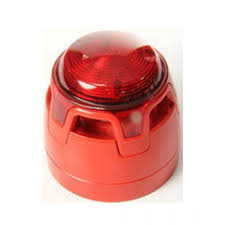Sounder & Flasher
Sounder and flasher are components commonly used in fire alarm systems and emergency notification systems to provide both audible and visual alerts during fire or emergency situations. These devices are designed to alert building occupants and facilitate a prompt and safe evacuation. Here’s a brief overview of each:
1. Sounder: A sounder, also known as an audible alarm or horn, is a device that emits a loud audible signal to alert people in the area about a fire or emergency. It produces distinct alarm tones or continuous sound patterns to draw attention and prompt evacuation. Sounders come in various sound levels and tones to suit different environments and requirements.
2. Flasher (Visual Alarm Device): A flasher, also called a visual alarm device (VAD) or strobe light, provides a visual alert by flashing bright, attention-grabbing light signals. Flashers are particularly useful in areas with high ambient noise levels or for alerting individuals with hearing impairments. They enhance the effectiveness of the alarm system by complementing the audible alarm with a visual indication.
In combination, sounders and flashers create a comprehensive audio-visual alarm system that ensures everyone in the building can receive timely and clear alerts during emergencies. These devices are typically integrated into fire alarm control panels and are strategically placed in hallways, stairwells, common areas, and other critical locations to provide maximum coverage and effective notification.
Sounder and flasher devices are essential components of fire alarm and emergency notification systems, providing both audible and visual alerts during fire or emergency situations. Here are the types of sounders and flashers commonly used:
Types of Sounders:
1. Piezoelectric Sounder: These sounders use the piezoelectric effect to produce sound. They are compact, energy-efficient, and emit loud and clear audible signals.
2. Electromagnetic Sounder: Electromagnetic sounders use a diaphragm and coil to generate sound when an electrical current passes through the coil. They are versatile and widely used in various applications.
3. Electronic Sounder: Electronic sounders utilize electronic circuitry to produce different alarm tones and sound patterns. They offer flexibility in generating a wide range of sounds.
Types of Flashers (Visual Alarm Devices):
1. Xenon Strobe Light: Xenon strobe lights use xenon gas to create short bursts of intense, high-energy flashes. They are highly effective in attracting attention and are commonly used in noisy environments.
2. LED Strobe Light: LED strobe lights use light-emitting diodes (LEDs) to produce bright flashes. They are energy-efficient, have a longer lifespan, and are often used as visual alarm devices.
3. Combination Sounder-Flasher: Some devices combine both the sounder and flasher functions in one unit. These combination devices offer both audible and visual alerts simultaneously.
4. Addressable Flasher: Addressable flashers are connected to a digital fire alarm system and can be individually addressed, allowing for precise control and location-specific visual alerts.
5. Non-Addressable (Conventional) Flasher: Conventional flashers are connected to specific zones within the fire alarm system and provide a general indication of the activated zone.
Both sounders and flashers are vital for ensuring the safety of occupants during emergencies and enabling a timely and orderly evacuation. The specific types of sounders and flashers chosen for a fire alarm system depend on the environment, building layout, and specific requirements of the installation.

